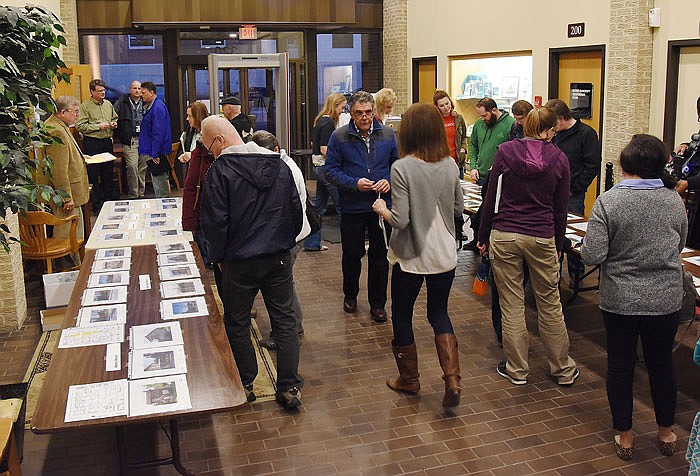In joint meeting at City Hall Tuesday night, the Jefferson City Council and the Housing Authority hosted what was promoted as a "listening session" on how to prioritize the East Capitol Avenue Area Urban Renewal.
Officials from both entities did indeed listen.
After a sampling of the 65 folks on hand had spoken, Housing Authority Executive Director Cynthia Quetsch gave them what they came to hear: the results of a straw poll on the structures in the area conducted in the lobby of City Hall before the listening began.
The winner was the irreplaceable Parsons House, a pre-Civil War relic at 105 Jackson St. Of those at the meeting, 33 had used one or more of their five sticky-notes to indicate their favorite was the Parsons House, thus urging Jefferson City's leaders to fix the tumbledown structure first as urban renewal begins in earnest this year.
The straw poll result was understandable to all attending.
In his seminal Jan. 24, 2007, white paper "Vision," for Historic City of Jefferson Inc., Mark S. Schreiber wrote, "At 105 Jackson Street stands probably the oldest remaining residence of the original City of Jefferson. The Gustavas A. Parsons' house is in sad need of repair. G.A. Parsons was a private secretary to Thomas Jefferson, a leading citizen and the father to Missouri Confederate Civil War Gen. Mosby Monroe Parsons."
In August 2016, the Parsons House was included on the Missouri Alliance for Historic Preservation's Places in Peril list. Right behind the cluster of votes for the Parsons House, with 24, 23, 22 and 19 votes, respectively, for the neglected buildings at:
- 108 Jackson St.;
- 500 E. Capitol Ave. (the storied "Ivy Terrace");
- 401 E. Capitol Ave.; and
- 103 Jackson St.
Ward 2 Councilman J. Rick Mihalevich, who chaired the meeting with Quetsch, opened the high-energy gathering reading a statement on behalf of Mayor Carrie Tergin.
"What was once the most grand avenue (of homes) in Jefferson City has now been left to fall like dominoes by their owners, those who should and will be held accountable by the law," Tergin wrote.
"Let's take their fragile buildings, which have been allowed to become broken by their owners, who have consistently violated city codes for years to the point of blight, and build them back up, each property like the rung of a ladder, building up the neighborhood that leads this historic avenue to our state Capitol on the west and redevelopment of the historic prison (MSP) to the east and surrounding neighborhoods.
"One of my top four goals as mayor at the start of 2016, this priority has taken many groups coming together. But what has most encouraged me is the magnitude of support, more than I ever imagined."
Cathy and Dave Bordner, who moved to East Capitol Avenue last year and restored an almost 100-year-old home, have emerged as two of the most vigorous advocates of this urban renewal project. They spoke separately Tuesday night.
Dave Bordner had a three-step plan of action to recommend to the City Council and the Housing Authority:
Increase the number of owner-occupied homes. There are several single-family homes both small and large that should be acquired and offered for sale; increase the number of residents living in the existing small apartment units. There are at least eight four-to-six unit apartments along E. Capitol in the "May Be Acquired" area; encourage more retail and commercial investment to attract more people to live in the area. There are several parcels on the "May Be Acquired List" that would work.
He also had some "no" ideas:
No property should be sold to any government entity whether it is city, county, state or federal. All sales of property should be to entities that will generate tax revenue. No property should be sold to become additional parking for the Federal Courthouse or for any other entity already in the location. No property should be sold to any developer that will build high density residential housing of more than 25 units.
Cathy Bordner had her three-point plan, too:
Revitalize the East Capitol Urban Renewal Area; Preserve the historic character of the neighborhood; Get more people living in the area as quickly as possible by rehabbing homes for people who are owner occupants and for residential rentals.
"It is my fervent hope that as your first step in this process, the last thing you will do is to tear down any of the buildings," said Steve Veile, a property owner at 512 E. Capitol Ave. for 33 years. "While a building or two may need to be torn down eventually, if that is the first step taken in this process. It will send a horrible message to the community and to all of those who support this effort."
Veile suggested the most historic properties be addressed first, notably the Standish and Parsons homes.
"While these are not 'showcase' homes, they are of great historic value, and addressing them first would demonstrate to the community the value of this urban renewal program in terms of saving important parts of the fabric of Old Town," he said.
Quetsch said the Housing Authority will accept written comments about prioritizing the urban renewal projects at [email protected] until 4:30 p.m. today.
Afterward, the City Council and Housing Authority would reconvene and make the choices of which structures will be first to receive restoration.

